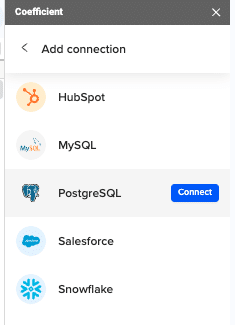Are you considering a move from MySQL to PostgreSQL? This comprehensive guide will walk you through the process of migrating your data, highlighting common challenges, benefits, and top methods.
We’ll also provide a detailed step-by-step walkthrough using Coefficient to simplify your migration journey.
MySQL to PostgreSQL Migration: Getting Started
MySQL and PostgreSQL are both popular relational database management systems, but they have distinct features and capabilities. MySQL is known for its ease of use and fast read operations, while PostgreSQL offers advanced features and better support for complex queries.
Key Differences Between MySQL and PostgreSQL
Understanding the differences between these databases is crucial for a successful migration:
- Data types: PostgreSQL supports a wider range of data types, including arrays and JSON.
- Concurrency: PostgreSQL uses multiversion concurrency control (MVCC), while MySQL uses table-level locking.
- Replication: Both offer replication, but PostgreSQL’s logical replication is more flexible.
- Full-text search: PostgreSQL has built-in full-text search capabilities.
Why Migrate from MySQL to PostgreSQL?
Despite the challenges, migrating to PostgreSQL offers significant benefits:
Improved Scalability and Performance
PostgreSQL excels in handling large-scale databases and complex queries. Its architecture allows for better performance with:
- Efficient handling of concurrent transactions.
- Better support for multi-core processors.
- Advanced indexing options for optimized query performance.
Advanced Features and Extensibility
PostgreSQL offers a rich set of features that can enhance your database capabilities:
- Support for JSON and other NoSQL-like features.
- Custom data types and functions.
- Full-text search capabilities.
Better Compliance with SQL Standards
PostgreSQL closely follows SQL standards, which can lead to:
- Easier portability of applications between different database systems.
- More predictable behavior for complex SQL operations.
Enhanced Data Integrity and Reliability
PostgreSQL provides robust mechanisms for ensuring data integrity:
- Stronger enforcement of constraints.
- Support for transactional DDL operations.
- Advanced backup and recovery options.
Common Challenges in Migrating from MySQL to PostgreSQL
Migrating from MySQL to PostgreSQL can present several challenges:
Data Type Incompatibilities
Some MySQL data types don’t have direct equivalents in PostgreSQL. For example:
- MySQL’s UNSIGNED INTEGER doesn’t exist in PostgreSQL.
- ENUM types in MySQL need to be converted to CHECK constraints in PostgreSQL.
Differences in SQL Syntax and Features
PostgreSQL and MySQL have different SQL dialects. Some key differences include:
- PostgreSQL uses double quotes for identifiers, while MySQL uses backticks.
- PostgreSQL is more strict about GROUP BY clauses.
- MySQL’s IF statement is replaced by CASE in PostgreSQL.
Performance Considerations During Migration
Migration can impact database performance. Consider these factors:
- Indexing strategies may need to be adjusted for PostgreSQL.
- Query optimization techniques differ between the two databases.
- PostgreSQL’s MVCC may require different tuning approaches.
Data Integrity and Consistency
Maintaining data integrity during migration is crucial. Key considerations include:
- Handling of NULL values and default constraints.
- Ensuring foreign key relationships are preserved.Managing auto-increment columns (sequences in PostgreSQL).
Pro-Tip: Analyze Your Database Before Migration
Before you move your data from MySQL to PostgreSQL, take a close look at your current database. This will help you plan better and spot any potential issues early on.
Coefficient can help you with this step. It’s a tool that pulls live data from your MySQL database into spreadsheets like Google Sheets or Excel. This makes it easier to examine your data without messing with your live database.
Here’s how you can use Coefficient to prepare for your migration:
- Check Your Database Structure:
- Connect Coefficient to your MySQL database
- Pull in your table structures
- Look at how your tables connect and what kind of data they hold
- Spot any data types that might cause problems when you switch to PostgreSQL
- Look at Your Data:
- Use Coefficient to grab samples of your data
- Use spreadsheet tools to see how your data is spread out
- Find any odd data that doesn’t fit the pattern
- Check for data quality issues like missing information
- Study How You Use Your Database:
- Pull in logs of database queries
- Break down these queries to see how you’re using your data
- This will help you set up PostgreSQL in the best way
- Set Performance Benchmarks:
- Use Coefficient to pull out speed stats for your important queries
- Save these in your spreadsheet
- You’ll use these later to make sure your new PostgreSQL database is working well
By using Coefficient to look at your MySQL data in spreadsheets, you can plan your move to PostgreSQL more easily. You’ll spot potential problems early and be better prepared for the switch.
How to Migrate MySQL to PostgreSQL with Coefficient (No-code)
Step 1. Install and Setup Coefficient:
- Install the Coefficient add-on in Google Sheets from the Google Workspace Marketplace. Follow the prompts to complete the installation and authorize access to MySQL and PostgreSQL if necessary.
Step 2. Import Data from MySQL:
- Launch Coefficient from the Extensions menu in Google Sheets.
- Select “Import from” and choose “MySQL.”

- Enter your MySQL credentials (host, database name, username, password) and choose your import method.

- Customize your import by selecting columns, filtering data, etc.

- Click Import to finish

Step 3. Export Data to PostgreSQL
- Choose “Export to” in Coefficient and select PostgreSQL.

- Map the columns from your Google Sheet to the PostgreSQL table fields.

- Specify the appropriate action (Insert, Update, Upsert, or Delete) and confirm your settings.
- Highlight the specific rows in your sheet to export or choose to export all rows, then click “Export” to push the data into PostgreSQL.

When the Export to PostgreSQL is complete (and successful), you can see the number of rows exported/skipped.
Top Methods for Migrating MySQL to PostgreSQL
Let’s explore the main approaches to migrating your data from MySQL to PostgreSQL.
Using pgloader
pgloader is a popular tool for migrating data from various sources to PostgreSQL.
pgloader is a command-line tool that can handle full database migration, including schema conversion and data transfer.
Key Features and Benefits
- Automatic schema conversion.
- Handles large datasets efficiently.
- Provides detailed logs and error reporting.
Step-by-Step Guide for Using pgloader
- Install pgloader on your system.
Create a configuration file (e.g., migration.load) with the following content:
LOAD DATABASE
FROM mysql://user:password@host/mysql_db
INTO postgresql://user:password@host/pg_db
WITH include no drop, create tables, create indexes, reset sequences
SET work_mem to '128MB', maintenance_work_mem to '512 MB';
Run the migration command:pgloader migration.load
Review the logs for any errors or warnings.
Verify the data in the PostgreSQL database.
Manual Migration Process
For more control over the migration process, you can perform a manual migration.
Exporting Data from MySQL
- Use mysqldump to export your data:
mysqldump -u username -p database_name > dump.sql - Review the dump file and adjust any MySQL-specific syntax.
Importing Data into PostgreSQL
- Create the target database in PostgreSQL:
createdb target_database - Import the modified dump file:
psql -d target_database -f dump.sql - Address any errors that occur during import.
ETL Tools and Third-Party Solutions
Several ETL (Extract, Transform, Load) tools can facilitate MySQL to PostgreSQL migration:
- Talend Open Studio
- Pentaho Data Integration
- AWS Database Migration Service
These tools often provide graphical interfaces and can handle complex transformations.
Custom Scripting Options
For unique migration requirements, custom scripts may be necessary. This approach typically involves:
- Extracting data from MySQL using a programming language (e.g., Python, Perl).
- Transforming the data to fit PostgreSQL’s requirements.
- Loading the transformed data into PostgreSQL.
Example Python script outline:
import mysql.connector
import psycopg2
# Connect to MySQL
mysql_conn = mysql.connector.connect(...)
# Connect to PostgreSQL
pg_conn = psycopg2.connect(...)
# Extract data from MySQL
mysql_cursor = mysql_conn.cursor()
mysql_cursor.execute("SELECT * FROM source_table")
# Transform and load data into PostgreSQL
pg_cursor = pg_conn.cursor()
for row in mysql_cursor:
# Transform data as needed
pg_cursor.execute("INSERT INTO target_table VALUES (...)", transformed_row)
pg_conn.commit()
Best Practices and Tips for Successful Migration
To ensure a smooth migration process, consider the following best practices:
Handling Schema Differences
- Map MySQL data types to appropriate PostgreSQL types.
- Rewrite MySQL-specific functions and stored procedures for PostgreSQL.
- Adjust auto-increment columns to use PostgreSQL sequences.
Incremental Migration Support
During the migration, use Coefficient to create blended reports pulling data from both the old and new databases. This ensures business continuity and allows for real-time comparison of data between systems. Here’s how:
- Connect Coefficient to both your MySQL and PostgreSQL databases.
- Create a report in Google Sheets or Excel that pulls data from both sources.
- Use Coefficient’s data refresh feature to keep the report updated in real-time.
- Set up alerts in Coefficient to notify you of any discrepancies between the two databases.
This approach allows you to monitor the migration process closely and catch any issues early.
Dealing with Data Type Conversions
- Pay special attention to date/time fields and their formats.
- Handle ENUM types by creating CHECK constraints in PostgreSQL.
- Convert MySQL’s UNSIGNED integers to appropriate PostgreSQL types.
Optimizing PostgreSQL After Migration
- Rebuild indexes for optimal performance.
- Update statistics to help the query planner.
- Adjust PostgreSQL configuration parameters based on your workload.
Power Up Your PostgreSQL: Real-Time Insights Await
Migrating to PostgreSQL unlocks advanced database capabilities, but that’s just the beginning. The real power lies in how you leverage your newly enhanced data ecosystem.
With your PostgreSQL migration complete, it’s time to supercharge your data workflow. Imagine seamlessly connecting your new database to your spreadsheets, enabling real-time reporting and analytics without the hassle of manual exports.
Ready to transform your PostgreSQL data into actionable insights? Discover how Coefficient can sync your database directly to Excel and Google Sheets, empowering your team with live, accurate data at their fingertips.





